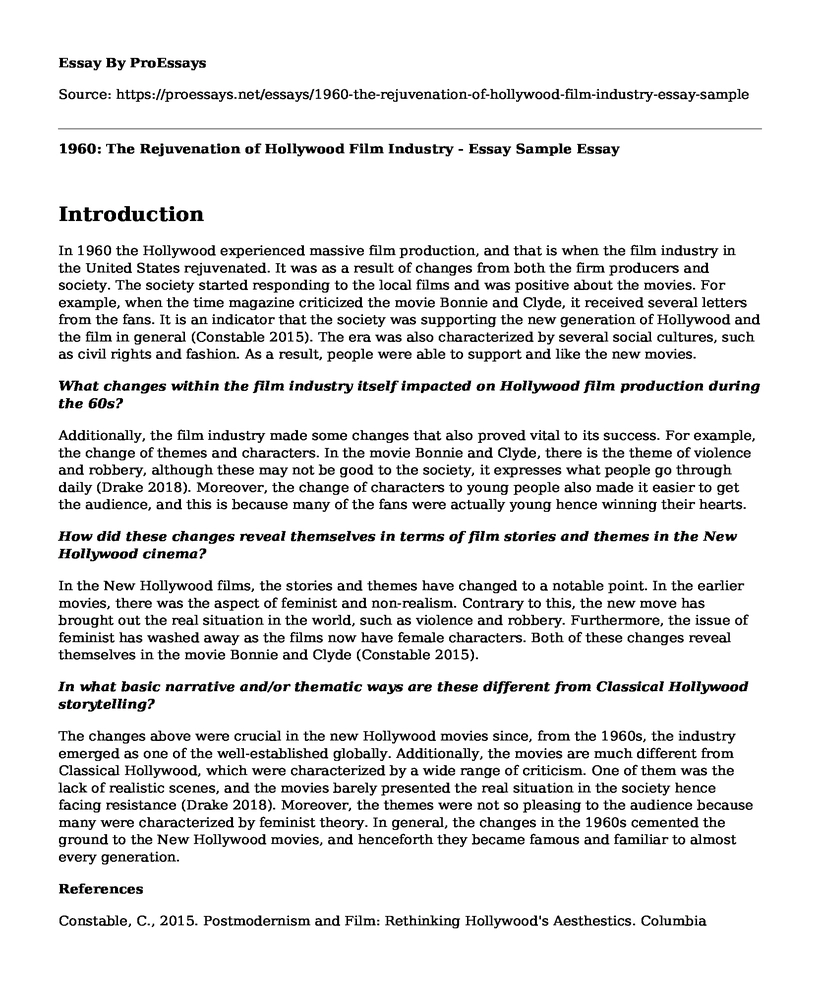Introduction
In 1960 the Hollywood experienced massive film production, and that is when the film industry in the United States rejuvenated. It was as a result of changes from both the firm producers and society. The society started responding to the local films and was positive about the movies. For example, when the time magazine criticized the movie Bonnie and Clyde, it received several letters from the fans. It is an indicator that the society was supporting the new generation of Hollywood and the film in general (Constable 2015). The era was also characterized by several social cultures, such as civil rights and fashion. As a result, people were able to support and like the new movies.
What changes within the film industry itself impacted on Hollywood film production during the 60s?
Additionally, the film industry made some changes that also proved vital to its success. For example, the change of themes and characters. In the movie Bonnie and Clyde, there is the theme of violence and robbery, although these may not be good to the society, it expresses what people go through daily (Drake 2018). Moreover, the change of characters to young people also made it easier to get the audience, and this is because many of the fans were actually young hence winning their hearts.
How did these changes reveal themselves in terms of film stories and themes in the New Hollywood cinema?
In the New Hollywood films, the stories and themes have changed to a notable point. In the earlier movies, there was the aspect of feminist and non-realism. Contrary to this, the new move has brought out the real situation in the world, such as violence and robbery. Furthermore, the issue of feminist has washed away as the films now have female characters. Both of these changes reveal themselves in the movie Bonnie and Clyde (Constable 2015).
In what basic narrative and/or thematic ways are these different from Classical Hollywood storytelling?
The changes above were crucial in the new Hollywood movies since, from the 1960s, the industry emerged as one of the well-established globally. Additionally, the movies are much different from Classical Hollywood, which were characterized by a wide range of criticism. One of them was the lack of realistic scenes, and the movies barely presented the real situation in the society hence facing resistance (Drake 2018). Moreover, the themes were not so pleasing to the audience because many were characterized by feminist theory. In general, the changes in the 1960s cemented the ground to the New Hollywood movies, and henceforth they became famous and familiar to almost every generation.
References
Constable, C., 2015. Postmodernism and Film: Rethinking Hollywood's Aesthestics. Columbia University Press. https://books.google.com/books?hl=en&lr=&id=S3ipBgAAQBAJ&oi=fnd&pg=PT8&dq=bonnie+and+clyde+new+hollywood&ots=bCAV3cjgsT&sig=isOQaZy0IJISuJZZ0dHziy_Ozeg
Drake, P., 2018. 'Mortgaged to music': New retro movies in 1990s Hollywood cinema. In Memory and popular film. Manchester University Press. https://www.manchesteropenhive.com/view/9781526137531/9781526137531.00017.xml
Cite this page
1960: The Rejuvenation of Hollywood Film Industry - Essay Sample. (2023, Jun 08). Retrieved from https://proessays.net/essays/1960-the-rejuvenation-of-hollywood-film-industry-essay-sample
If you are the original author of this essay and no longer wish to have it published on the ProEssays website, please click below to request its removal:
- Critical Essay on Picasso's Demoiselles D'Avignon
- Film Analysis Essay on Creed: Knockout Storytelling of Never Giving Up
- Young Life and Clothes: Exploring Self-Identity and Style - Essay Sample
- Essay Sample on Propaganda vs. Public Relations: Comparing Definitions & Interpretations
- Film Analysis Essay on Apollo 13: The Journey to Successful American Space Exploration
- Paper Example on UK Building Regulations: Ensuring Safety, Accessibility, and Environmental Protection
- Traditional Dancing and Thoughtful Reflection: A Caribbean/African Perspective - Essay Sample







